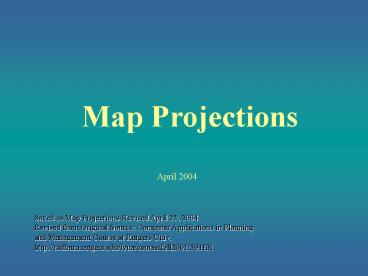Map Projections - PowerPoint PPT Presentation
1 / 22
Title:
Map Projections
Description:
Map Projections. All projections distort some combina-tion of either ... Africa, in reality is 14X larger than Greenland in area. Poles cannot be shown ... – PowerPoint PPT presentation
Number of Views:169
Avg rating:3.0/5.0
Title: Map Projections
1
Map Projections
April 2004
Saved as Map Projections-Revised April 25,
2004 Revised from Original Source Computer
Applications in Planning and Management Course
at Rutgers Univ. http//radburn.rutgers.edu/lyna/
course/fall2001/591f01
2
- GIS programs must know what projection type is
being used during map creation. - Maps or satellite images in different projections
will NOT overlay properly in GIS. - Dont let this happen to you!
3
Map Projections
Map Projection - An orderly method used to
represent all or part of a 3D globe onto a 2D map.
4
Map Projections
All maps lie flat, therefore all maps lie
- All projections distort some combina-tion of
either - the shape,
- size,
- distance or
- direction of land masses, (e.g., continents,
islands, etc.).
5
- Thus, the best projection depends upon the use of
the map.
6
Types of Projections
- Equidistant Projections
- Azimuthal Projections
- Conformal Projections
- Equivalent/Equal Area Projections
7
Equidistant Projections are good for length and
perimeter measurements. Azimuthal Projections are
good for accurate direction, or compass bearing.
Conformal Projections attempt to represent
shapes correctly but relative sizes are
off. Equivalent/Equal Area Projections distort
shapes but show areas proportionate to their
actual areas.
8
- Map Projections Families Examples
9
Conformal vs. Equal-area The Great Debate
Shows true size - squishes or stretches shapes
Preserves true shape - exaggerates areas
Conformal
Equal-area
10
Cylindrical Projections
- Globe is projected onto a cylinder tangent at
equator - Low distortion at equator
- Higher distortion approaching poles
- A good choice for use in equatorial and tropical
regions, e.g., Ecuador, Kenya, Malaysia
11
Example of a Cylindrical Projection Mercator
- Invented by Gerhardus Mercator - Flemish
cartographer - in 1569
Gerhardus Mercator
12
- A special purpose projection, intended as a
navigational tool - A straight line between two points gives a
constant compass bearing to the destination
13
Problems with Mercator
- Mercator is a special purpose projection that is
deceiving in general purpose use - Preserves shapes (a conformal type) but distorts
area - Used by John Birch Society in Cold War to show
Red Menace - Africa, in reality is 14X larger than Greenland
in area - Poles cannot be shown
USSR
Eastern Bloc
Red China
14
Conic Projections
- Surface of globe projected onto cone tangent at
standard parallel. - Distorts N S of standard parallel(s)
- Normally shows just one semihemisphere in middle
latitudes.
15
- Lambert Conformal Conic is a widely used example.
16
Elliptical/Pseudocylindrical (football) Projection
- Tend to be equivalent (equal-area)
- Not bad for world maps
Example Mollweide Projection
17
Planar or Polar Projection
- Surface of globe is projected onto a plane
tangent at only one point (frequently N or S
pole). - Usually only one hemisphere shown (centered on N
or S pole). - Works well to highlight an area.
- Shows true bearing and distance to other points
from center or point of tangency.
18
Goodes Homosoline Interrupted Elliptical
Projection
- Mild distortion of shapes
- Interrupts areas - oceans, Greenland
- Equivalent/equal area
- Good for climate, soils, landcover - latitude and
area comparisons
19
Transformations between Geometric Projections
- Any data layers to be used together in analysis
- Should be represented in the same projection
- To completely understand projections, we first
need to - understand the basic principles of the
latitude/longitude - Coordinate system.
20
The Geographic Grid
- Parallels - lines of latitude parallel to the
equator. - Meridians - lines of longitude running through
poles. - The equator and all meridians are great circles.
Graticule - a system of parallels and meridians
21
Coordinate Systems
Latitude and Longitude
- Lines of latitude begin at the equator and
increase N and S toward the poles from 0o to 90o. - Degrees of Latitude are constant.
- Lines of longitude begin at some great circle
(prime meridian) passing through some arbitrary
point. - 1o of Long. 1o of Latitude only at Equator
Long. degrees smaller towards poles due to
convergence. - 1o of Long. varies in length, 111 km at equator,
0 km at poles.
22
The Prime Meridian - where to begin?!?
- France used Ferro Island in the Canaries for over
150 yrs. - Germany also used Ferro, but with a slightly
different point of origin. - Also used Athens, Berlin, Beijing, Madrid,
Moscow, Paris, Rome, Tokyo, and many more. - US has used Philadelphia, London, and Washington,
DC. - During late 1800s lots of British seacharts used
Greenwich. - In 1884 International Meridian Conference in DC
officially adopted Greenwich as the P.M. - Meridians numbered up to 180 degrees E and W of
Greenwich.
The Royal Observatory, Greenwich, England

